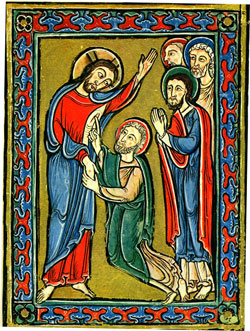 As a 25 year-old newly-ordained minister and only the second woman serving a full-time call in a metropolitan area of over 400,000 people, I remember feeling very alone at times. But even more daunting than the loneliness was the realization that I was encountering situations for which seminary had never prepared me. I was part of a pastoral colleague group whose mentor was wise and caring. I was blessed with a bishop and judicatory leadership that was strongly supportive too. But what I wouldn’t have given for the opportunity to check in with and run situations past another woman who had some significant experience in pastoral ministry, and was still passionate about it! And a group of women like that - well, that would have been the whipped cream and dark chocolate drizzled on the latte!
As a 25 year-old newly-ordained minister and only the second woman serving a full-time call in a metropolitan area of over 400,000 people, I remember feeling very alone at times. But even more daunting than the loneliness was the realization that I was encountering situations for which seminary had never prepared me. I was part of a pastoral colleague group whose mentor was wise and caring. I was blessed with a bishop and judicatory leadership that was strongly supportive too. But what I wouldn’t have given for the opportunity to check in with and run situations past another woman who had some significant experience in pastoral ministry, and was still passionate about it! And a group of women like that - well, that would have been the whipped cream and dark chocolate drizzled on the latte! What do you do when you realize a few months into your tenure that the woman who has been the de facto lay leader of the congregation is deeply threatened by your presence?
How do you function as a leader in a setting where the life events that make one an adult – marriage and child-bearing – aren’t a part of your life’s story?
What do you do when you have the sneaking suspicion that something is terribly wrong with the congregation’s financial management?
What do you do when you begin to think you would be happier flipping hamburgers at the local fast-food establishment than pasturing your parish?
Does any woman make it beyond six or seven years of this work?
These are but a few of the questions I would have brought to “Ask the Matriarch” during my first 3 years of ministry. RevGalBlogPals hadn’t come into existence at that point. Friends – the internet hadn’t even been invented yet!
Today both the internet and RevGalBlogPals provide a means of community for ordained women and those who support them that reaches across denominational lines and around the globe. In August 2006, “Ask the Matriarch’ was proposed as a weekly event on the RevGals site with the specific objective of linking persons new to ordained ministry with questions and struggles with women who had at least 10 years of ordained ministry experience. Judging from the steady stream of questions and responses to them, this feature continues to provide a setting for support and conversation across a range of subjects in pastoral leadership.
I consider it a privilege to be able to be a part of the RevGals community and this feature. There are five matriarchs who join me in this endeavor, but we really would benefit from a few more women with significant ordained experience (10 years is our chosen benchmark) to help shoulder the work when life gets busy for any of us. If you are interested in joining our merry band of matriarchs, drop us a line at askthematriarch@gmail.com.
And as always, we need your questions to make this feature work. You don't have to be new in ordained ministry...whatever your tenure or situation, your questions are respected and valued. You can forward them to us at askthematriarch@gmail.com
We’ll be back with ATM in its regular format next Thursday…hope to see you then.
May you live in God’s amazing grace+
revhoney
(Photo courtesy of WorldofStock.com)

















.jpg)








